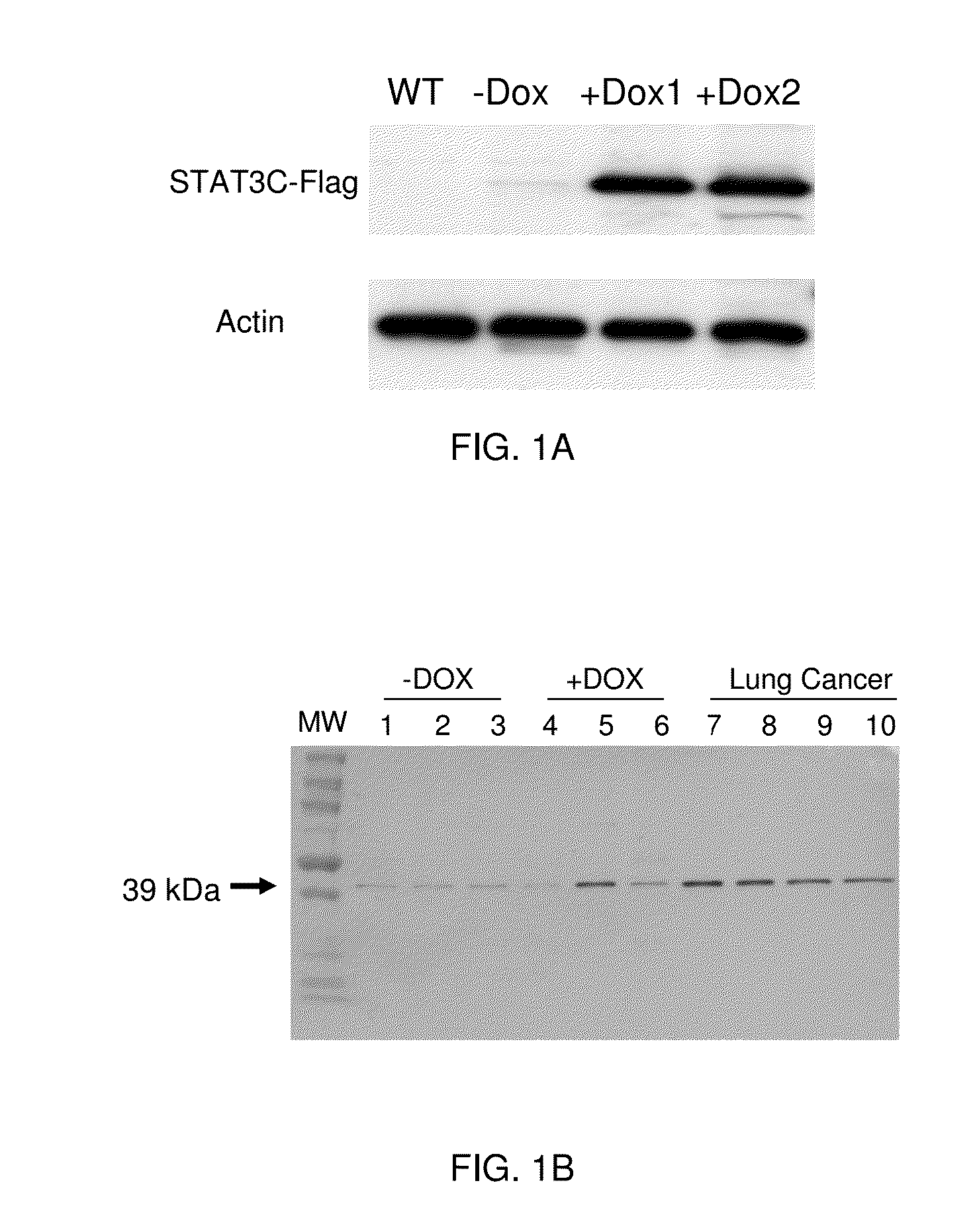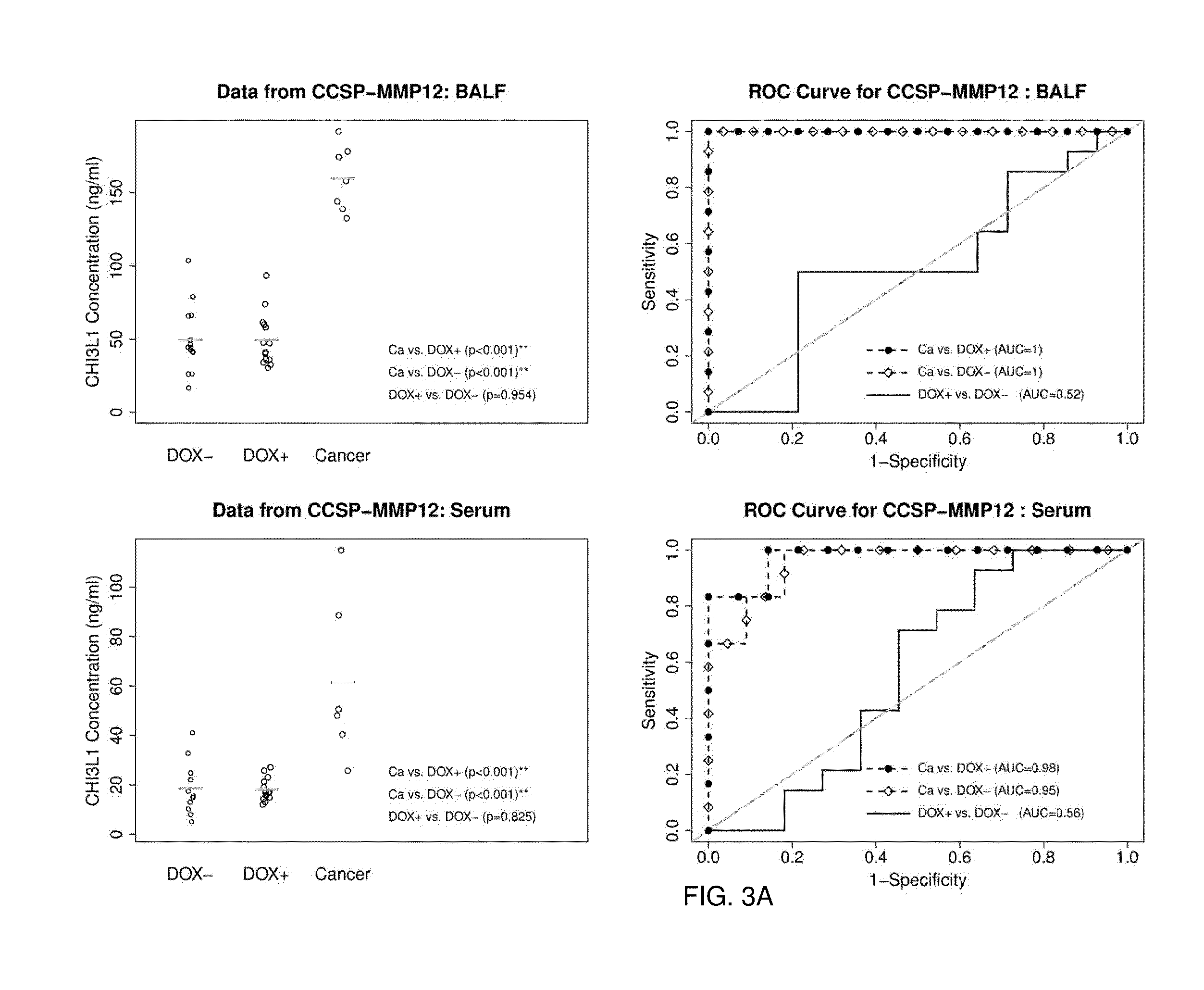Compositions and Methods for Diagnosing Lung Cancer
a technology applied in the field of compositions and methods for diagnosing lung cancer, can solve the problem that lung cancer is a difficult disease to d
- Summary
- Abstract
- Description
- Claims
- Application Information
AI Technical Summary
Benefits of technology
Problems solved by technology
Method used
Image
Examples
example 1
Materials and Methods
[0122]Animal Care
[0123]All scientific protocols involving the use of animals have been approved by the Institutional Animal Care and Use Committee (IACUC) of Indiana University School of Medicine and followed guidelines established by the Panel on Euthanasia of the American Veterinary Medical Association. Protocols involving the use of recombinant DNA or biohazardous materials have been approved by the Biosafety Committee of Indiana University School of Medicine and followed guidelines established by the National Institutes of Health Animals were housed under (IACUC)—approved conditions in a secure animal facility at Indiana University School of Medicine.
[0124]ELISA
[0125]For mouse serum collection, the abdominal cavities of doxycycline-treated or untreated CCSP-rtTA / (TetO)7-CMV-Stat3, CCSP-rtTA / (TetO)7-CMV-MMP12, CCSP-rtTA / (TetO)7-CMV-Api6, c-fms-rtTA / (TetO)7-CMV-Api6 and c-fms-rtTA / (TetO)7-CMV-MMP12 bitransgenic mice were opened after anesthetizing with triple ...
example 2
Western Blot Analysis of CHI3L1 Expression in BALF of CCSP-rtTA / (TetO)7-CMV-Stat3C Mice
[0137]CCSP-rtTA / (TetO)7-CMV-Stat3C mice is a spontaneous lung tumor animal model. In this model, Stat3C-Flag fusion protein was highly inducible by doxycycline treatment (FIG. 1A). To test if CHI3L1 is a secretory protein in this mouse model, Western blot analysis was performed in BALF of CCSP-rtTA / (TetO)7-CMV-Stat3C mice. As shown in FIG. 1, the CHI3L1 protein expression level was detectable in BALF of doxycycline-untreated mice (−DOX, Lanes 1, 2, and 3) as one band at 39 kDa molecular weight. In comparison, the CHI3L1 protein expression level was increased in one of three doxycycline-treated mice without tumor (+DOX, lane 5), indicating that CHI3L1 expression was elevated prior to tumor formation, and in all four doxycycline-treated CCSP-rtTA / (TetO)7-CMV-Stat3C mice with tumor (Lung cancer, lanes 7, 8, 9, and 10).
example 3
CHI3L1 Protein Concentration in BALF and Serum from CCSP-rtTA / (TetO)7-CMV-Stat3C Mice
[0138]For more quantitative analysis and accurate prediction, ELISA was used to determine the CHI3L1 concentration in BALF of wild type, doxycycline-untreated, treated without tumor, and treated with tumor CCSP-rtTA / (TetO)7-CMV-Stat3C mice. The average CHI3L1 concentration was 8.3±6.4 ng / ml in wild type mice, 8.8±10 ng / ml in doxycycline-untreated CCSP-rtTA / (TetO)7-CMV-Stat3C mice. In comparison, the average CHI3L1 concentration was increased more than 11-fold (100.0±49.0 ng / ml, p<0.001) in doxycycline-treated mice without tumor, further supporting that CHI3L1 expression was elevated prior to tumor formation, and was increased more than 17-fold (151.8±67.3 ng / ml, p<0.001) in doxycycline-treated mice with tumor (FIG. 2, upper panel). The AUCs of the ROC curves are 1 (95% CI: 1-1, p<0.001) for discriminating doxycycline-treated mice with tumor vs. doxycycline-untreated mice, 1 (95% CI: 1-1, p<0.001) fo...
PUM
| Property | Measurement | Unit |
|---|---|---|
| Current | aaaaa | aaaaa |
Abstract
Description
Claims
Application Information
 Login to View More
Login to View More - R&D
- Intellectual Property
- Life Sciences
- Materials
- Tech Scout
- Unparalleled Data Quality
- Higher Quality Content
- 60% Fewer Hallucinations
Browse by: Latest US Patents, China's latest patents, Technical Efficacy Thesaurus, Application Domain, Technology Topic, Popular Technical Reports.
© 2025 PatSnap. All rights reserved.Legal|Privacy policy|Modern Slavery Act Transparency Statement|Sitemap|About US| Contact US: help@patsnap.com



